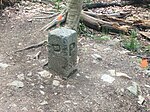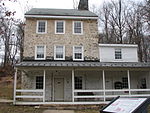Thompson Farm (London Britain Township, Pennsylvania)
1857 establishments in PennsylvaniaChester County, Pennsylvania Registered Historic Place stubsFarms on the National Register of Historic Places in PennsylvaniaHouses completed in 1857Houses in Chester County, Pennsylvania ... and 1 more
National Register of Historic Places in Chester County, Pennsylvania

Thompson Farm, also known as the Pierson Farm, is a historic home and farm located in London Britain Township, Chester County, Pennsylvania. It has five contributing buildings. They are a brick farmhouse, a stone and frame bank barn (c. 1800), frame outhouse, chicken house, and corn crib. The farmhouse was built in 1833, and expanded in 1857.It was added to the National Register of Historic Places in 1983.
Excerpt from the Wikipedia article Thompson Farm (London Britain Township, Pennsylvania) (License: CC BY-SA 3.0, Authors, Images).Thompson Farm (London Britain Township, Pennsylvania)
Chambers Rock Road, London Britain Township
Geographical coordinates (GPS) Address Nearby Places Show on map
Geographical coordinates (GPS)
| Latitude | Longitude |
|---|---|
| N 39.731666666667 ° | E -75.7825 ° |
Address
Chambers Rock Road 622
19350 London Britain Township
Pennsylvania, United States
Open on Google Maps








